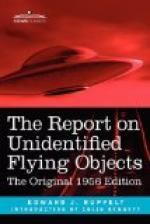While the people on Project Sign were pondering over Lieutenant Gorman’s dogfight with the UFO—at the time they weren’t even considering the balloon angle—the Top Secret Estimate of the Situation was working its way up into the higher echelons of the Air Force. It got to the late General Hoyt S. Vandenberg, then Chief of Staff, before it was batted back down. The general wouldn’t buy interplanetary vehicles. The report lacked proof. A group from ATIC went to the Pentagon to bolster their position but had no luck, the Chief of Staff just couldn’t be convinced.
The estimate died a quick death. Some months later it was completely declassified and relegated to the incinerator. A few copies, one of which I saw, were kept as mementos of the golden days of the UFO’s.
The top Air Force command’s refusal to buy the interplanetary theory didn’t have any immediate effect upon the morale of Project Sign because the reports were getting better.
A belated report that is more of a collectors’ item than a good UFO sighting came into ATIC in the fall of 1948. It was from Moscow. Someone, I could never find out exactly who, reported a huge “smudge-like” object in the sky.
Then radar came into the picture. For months the anti-saucer factions had been pointing their fingers at the lack of radar reports, saying, “If they exist, why don’t they show up on radarscopes?” When they showed up on radarscopes, the UFO won some converts.
On October 15 an F-61, a World War II “Black Widow” night fighter, was on patrol over Japan when it picked up an unidentified target on its radar. The target was flying between 5,000 and 6,000 feet and traveling about 200 miles per hour. When the F-61 tried to intercept it would get to within 12,000 feet of the UFO only to have it accelerate to an estimated 1,200 miles per hour, leaving the F-61 far behind before slowing down again. The F-61 crew made six attempts to close on the UFO. On one pass, the crew said, they did get close enough to see its silhouette. It was 20 to 30 feet long and looked “like a rifle bullet.”
Toward the end of November a wire came into Project Sign from Germany. It was the first report where a UFO was seen and simultaneously picked up on radar. This type of report, the first of many to come, is one of the better types of UFO reports. The wire said:
At 2200 hours, local time, 23 November 1948, Capt. ------ saw an object in the air directly east of this base. It was at an unknown altitude. It looked like a reddish star and was moving in a southerly direction across Munich, turning slightly to the southwest then the southeast. The speed could have been between 200 to 600 mph, the actual speed could not be estimated, not knowing the height. Capt. —– —– called base operations and they called the radar station. Radar reported that they had seen nothing on their scope but would check again. Radar then called operations to report that they did have a




